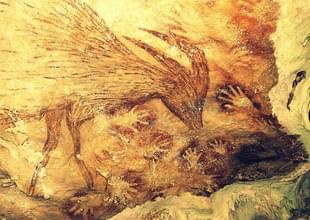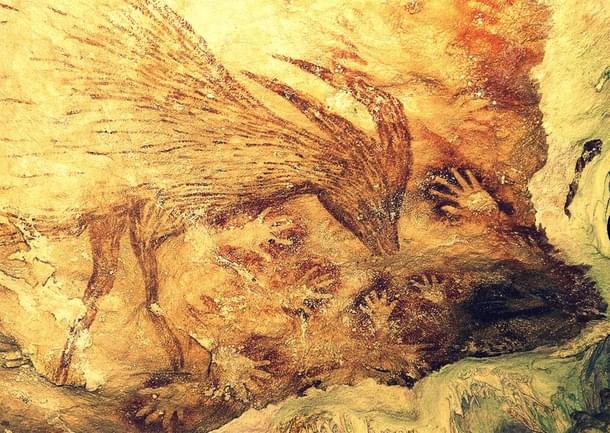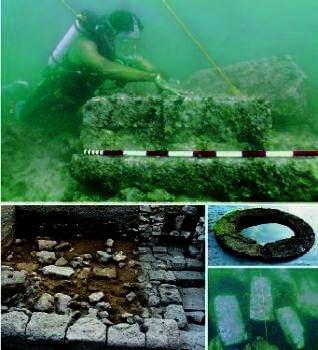Culture
Cave Art Caveat
Aravindan Neelakandan
Oct 24, 2014, 11:30 AM | Updated Feb 19, 2016, 06:18 PM IST
Save & read from anywhere!
Bookmark stories for easy access on any device or the Swarajya app.


Forty thousand years ago, in what is now the European continent, the inside walls of caves exploded with human creativity. Paintings started appearing that had shamanic and paleo-astronomical significance. Art—particularly symbolic art—originated here, in the wombs of these grottos, and in the grey cells of the earliest humans living in Europe. The rest of the world slowly caught up.
Or so we were told.
However, a recent study published in the British science journal Nature by a team of Australian archaeologists about the Sulawesi cave art in Indonesia tells an entirely different story. To quote from the article:
The researchers dated 12 stencils of human hands and two images of large animals. Because they sampled the top layer of calcium carbonate, the uranium dating technique gave them a minimum age for each sample. They found that the oldest stencil was at least 39,900 years old—2,000 years older than the minimum age of the oldest European hand stencil. An image of a babirusa, or ‘pig-deer’, resembling an aubergine with stick-like legs jutting from each end, was estimated to be 35,400 years old—around the same age as the earliest large animal pictures in European caves. [1]

(Pic Above -Hand stencils from a cave in Sulawesi, are common in prehistoric art) Pic Courtesy-VOA
Sulawesi cave art was discovered discovered as early as 1950s. Yet unlike the Lascaux cave art in France, they never attracted the attention of those who constructed the grand narrative of human evolution. A popular science weekly from the UK bluntly stated the possible reason for this sidelining:
One reason the Eurocentric view took hold was a chauvinistic belief that the first Europeans were more sophisticated than people elsewhere.[2].
The Great Zimbabwe Ruins
It was politics too. When ruins of Great Zimbabwe—the capital of the Queen of Sheba, according to legend—were discovered, the colonial historians immediately denied blacks the authorship of the civilization. A tight control was unleashed at all levels for this denial. The ironclad censorship existed well into 1960s and 70s. Paul Sinclair, curator of archaeology, based in Zimbabwe, explains:
I was told that the museum service was in a difficult situation, that the government was pressurising them to withhold the correct information. Censorship of guidebooks, museum displays, school textbooks, radio programmes, newspapers and films was a daily occurrence. Once a member of the Museum Board of Trustees threatened me with losing my job if I said publicly that blacks had built Zimbabwe. He said it was okay to say the yellow people had built it, but I wasn’t allowed to mention radio carbon date. [3]

Pic Above : Great Zimbabwe: Tower in the Great Enclosure.
Dr Innocent Pikirayi, another archaeologist from the University of Zimbabwe, in a BBC interview, says how it was intertwined with colonial politics:
When African nationalists were demanding independence in the 1960s, the (Ian) Smith regime actually sanctioned historians to write a fake history on the origins of Great Zimbabwe, denying its African origins. This was not different from the accounts of the late 19th century and early 20th century antiquarians, which linked Great Zimbabwe with Phoenicia, with Saban Arabs, with the Egyptians and the rest of the near East. [4]
The Indian Story
We have seen such prejudices in action in India too, but much more nuanced—whether it is the vexed question of Aryan race theory or the submerged settlements in Gulf of Cambay, or the nature of Harappan culture or the mystery of the identification of the Vedic Saraswati river with the dried-up Ghaggar-Hakra.
It is very much plausible that the Gulf of Cambay ‘artifacts’ are products of natural weathering. It is equally possible that the identification of Ghaggar-Hakra with Saraswati may be wrong. But then there is every possibility that early human settlements might have been there sleeping under the turbulent waters of Gulf of Cambay. Vedic Saraswathi might very well be the Ghaggar-Hakra paleo-channel. The point is not whether certain conclusions are right or wrong but about resolutely rejecting a specific set of conclusions which often favour indigenous cultural and social developments in ancient history while a colonial worldview is subtly promoted.
This capture of ancient narrative seems to provide power to control future politics—it is a legacy of the colonial empire that still lingers in many parts of Asia and Africa—fuelled by a seemingly neutral western academic establishment, but unfortunately having disastrous even genocidal socio-political implications.
Consider the following two episodes from the annals of Indian archeology. The debate is overtly and consciously academic but the undercurrent is unmistakable.
Surkatoda Horse Teeth ‘Controversy’ [5]
British archeologist Richard Meadow wrote in 1987 that there were ‘no convincing reports of horse remains from archaeological sites in South Asia before the end of the second millennium BC. Many claims have been made (e.g., Sewell 1931; Nath 1962, 1968; Sharma 1974) but few have been documented with sufficient measurements, drawings and photographs to permit other analysts to judge for themselves’.

Pic Above : Surkatoda Horse Remains Pic Courtesy : Indian Archaeology Yahoo Group
Here one should note that apart from Sewell, who was an European from the colonial era, the other two archeologists Meadow dismisses are post-colonial Indian experts. In short, Meadow is questioning the professionalism of his Indian counterparts. Here the mention of Sharma is of particular interest. It refers to is the discovery of incisor and molar teeth, various phalanges and other bones from Equus caballus—the true horse. Dismissing this archeological find, Meadow wrote:
…on the basis of this phalanx that one can ascertain from the published photographs that the ‘horse’ of Surkotada, a Harappan period site in the little Rann of Kutch, … is likewise almost certainly a half-ass, albeit a large one.
It took two decades before a Hungarian paleo-zoologist Sándor Bökönyi examined the bones excavated at Surkotada and declared emphatically that they belonged to the domesticated true horse. What Indian archeologist A.K. Sharma stated later with regard to this vindication of his stand was important. After waiting for 20 years to get proper recognition for his discovery, he said on that day of his triumph:
This was the saddest day for … my findings had to wait two decades for recognition, until a man from another continent came, examined the material and declared that “Sharma was right.” When will we imbibe intellectual courage not to look across borders for approval?
Surkatoda horse molars were not a lonely exception. For instance, the curious case of dockyard as irrigation tank.
Lothal Dockyard ‘Controversy’
Lothal is a small Harappan city and industrial centre in the Saurashtra region of Gujarat. It was discovered and excavated in 1950s by Indian archeologist S.R. Rao. At Lothal, a trapezoidal brick basin 22 metres by 37 metres (with 4.5 to 4 metres depth) was excavated by Rao, which he identified as a dock into which vessels 20 x 6 metres could enter. This would make Lothal one of the earliest—perhaps the earliest—dock in the maritime history of humanity.
Then in 1968, Lawrence Leshnik of the South Asia Institute, Heidelberg, questioned whether it was a dock. He wrote that the settlement in Lothal and the basin identified by Rao as dock, do not ‘appear to meet the requirement of the port’ and alternatively suggested that the basin ‘could have served as an irrigation tank for a moderately-sized but still rural village’. Though Leshnik did remark that his view lacked ‘the weight of decisive evidence’, the crux of his argument was that the structure at Lothal could not have received the sea tides entering the basin.[6] The present Gulf of Cambay is 23 km from Lothal and the dock is presently 12 m above the current sea level. So even if the sea water level was 3 m higher, it could not have reached the dock.

Pic Above : Lothal Dockyard Pic Courtesy : http://www.harappa.com/
Soon, many eminent western archeologists as well as some important Indian archeologists working on Harappan archeology started stating that the identification of the basin as dockyard was ‘controversial’, and that an Indian archeologist was trying to create the world’s oldest dockyard out of an ordinary irrigation tank common to every Indian village (which was what Lothal had been!)
For example, consider this, by eminent anthropologist Gregory Possehl, who had closely studied Harappan excavations:
The most controversial feature at the site is a large, brick-lined enclosure that has been called a dockyard by the excavator of the site, S.R. Rao…K.T.M. Hedge has pointed out (1991, personal communication that this facility resulted from the removal of earth that was used to create the elevated portion of Lothal, on which the warehouse and other large structures of this district was built. … Thus the facility can be seen as an example of a South Asian tank something proposed by L.Leshnik and something with which I am in general agreement.[7]
In 1969, Romila Thapar had published her History of India which was much acclaimed by the Nehruvian and Western academic establishments. The book was updated and published by Penguin in 2003 under the title Penguin History of Early India. Here she informs her readers: ‘Lothal has evidence of a structure that has been described as a dockyard, although this description remains controversial’.
Thus the conventional wisdom had been manufactured: a misidentification by an overenthusiastic Indian archeologist and guarded response by world academic community, thanks to the alert raised by a Western scholar. Neither Leshnik nor Posshel nor the countless others who made the dockyard ‘controversial’ in their writings can be construed as racists or ‘imperialists’ by any stretch of the imagination. However, the overall narrative they generated did have an Euro-centric bias bordering on an Indo-phobic attitude.
As for Romila Thapar, the venerable Marxist historian committed to scientific presentation of Indian history, her sustained tagging of Lothal dock as ‘controversial’ needs some real explanation.
One should remember that Thapar’s ‘revised book’ on ancient Indian history was published in 2003. But almost 15 years ago Dr. Rajiv Nigam, head of the geological division of the National Institute of Oceanography, had made a study of microbial organisms from the sediment samples of the ‘controversial’ structure at Lothal. The sediments revealed a ‘fairly well-preserved assemblage of foraminifera—an exclusive marine organism—thereby indicating that Lothal was a part of marine environment’.
Given the fact that the main basis of objection to the Lothal structure being a dockyard was the supposed impossibility of tidal sea waters entering the basin, Nigam proved beyond a shadow of doubt that the Lothal basin did receive tidal marine waters. In his paper, Nigam points out:
Planktonic foraminifera thrive in open marine environment having at least moderate depth. Their rare presence on beaches has been attributed to high water which transport these specimens along with other material from the nearly off-shore zone, similarly it may be concluded that the presence of planktonic foraminifera in material from present study site indicate existence of high tidal range during Harappan times. [8]
This is yet another classic example of how general Western scholarship on the Harappan civilization (certainly with notable exceptions) has an inbuilt Indo-phobic bias and a multidisciplinary scientific approach coming to the rescue of truth.
Interestingly a scholar who credits herself as post-colonial and Marxist rather meekly accepted the pro-Western bias in the Lothal dock ‘controversy’ or perhaps simply overlooked the integrated scientific evidence emerging from her own people. This in turn may be because Marxism, to which she owes her ideological allegiance is inherently Euro-centric. Yet what is heartening is to see the emergence of refreshing scholarship beyond the boundary lines of politics and bias. Thus, Upinder Singh one of the finest historians of India today, writes in her 2008 book on ancient India:
The most distinctive feature of Lothal is the dockyard, which lies on the eastern edge of the site. This is a roughly trapezoid basin, enclosed by walls of burnt bricks. The eastern and western walls measured 212 m and 215 m respectively in length, while those on the north and south measured 37 m and 35 m. The dockyard had provisions for maintaining a regular level of water by means of a sluice gate and a spill channel. A mud-brick platform along the western embankment may have been the wharf where goods were loaded and unloaded. An alternative interpretation of this structure as a water reservoir is not convincing. [9]
Contrast Upinder Singh’s description of Lothal dockyard with the one-line statement of Thapar where she terms the structure ‘controversial’!
Beyond Archeological Maya
It is nobody’s contention that Indian archeologists make no mistakes. Even in the much trumpeted case of Dwarka marine excavations, there are problems. In their paper on Dwarka based on modern archeological studies, Gaur et al come to the following conclusion:
The studies of surrounding archaeological sites indicate that the submerged structure may not be as old as suggested earlier. However, the date of these structures may be still a matter of debate. A stone block with Gujarati script, found from the area indicates a later date for the stone structures. Recent discoveries of stone anchors from all over the coasts of Indian Ocean suggest that Dwarka anchors may be related to Indo-Arab trade between 8th century and 15th century AD. However the date of stone anchors is subject to revision in the light of their association with some archaeological sites. [10]
We are not exactly having a 23,000 years old submerged city here, as claimed on the net by a section of Hindutvaites and believers, nor do we have a submerged megacity built by civilization seeding fantasizers of the Graham Hancock variety. But all hope is not lost for those who want to in some way associate Krishna’s Dwarka with some marine archeological site.
In another paper on Bet Dwaraka island, marine archeologists Sundaresh and Gaur point out that Harappans settled on Bet Dwaraka island around early second millennium BCE:
The settlement on the southeastern side of the island was disturbed by wave action as can be seen from the cliff section facing the sea. Moreover a large quantity of pottery recovered from the intertidal zone supports the above inference. This evidence suggests that there was a rise in sea level, at least around Bet Dwaraka, but it is difficult to determine the causes of sea level rise at this stage. Later the site was deserted for a long period and again reoccupied in the 3rd-4th century BCE.[11]
There is a possibility that it was perhaps here that the core of the legend of the submerged ‘city’ of Dwaraka was born. But that was not in some distant yuga tens of thousands of years ago but during the late Harappan period.

Pic Above : An underwater archaeologist of the ASI examines an ancient structure off the shore of Dwaraka. Pic Courtesy-The Hindu
Clearly, it is important who controls the narrative of our past. Should we hand over the way our past is constructed to our erstwhile colonial ‘masters’ and faithfully follow their directions with our own ideological deconstructions of our culture and nationhood or are we going to create a robust self-critical rooted study of our own past by our indigenous scholarship?
This is an unenviable tightrope walk. Hate hawks from the western academic world like Harvard Indologist Michael Witzel, aided by our own academic sepoys like Thapar and Meera Nanda, are waiting in the wings to exaggerate, blow up and label every slip, every mistake, every faulty imaginative indulgence of Indic scholarship as ‘pseudo-scientific’ and ‘politically motivated’.
Hence novel, multi-disciplinary approaches to studying the past—as in the case of Nigam in the Lothal dockyard ‘controversy’—needs to be devised at the scholarly level. Then they need to be celebrated and imprinted in the general psyche of educated Indians through popular science writers. This is an uphill task. We already have our Bhimbetka cave paintings waiting for such an approach.
Coming back to the cave paintings of Indonesia, New Scientist concludes its small introduction to the recent dating of the Sulawesi cave paintings with the following words:
Nor can Indonesia claim to be the cradle of art. The paintings speak of a universal humanity—hand stencils and pictures of animals also dominate European art from around the same time. The origins of art surely lie in our ancestral home, Africa. In art, as in science, we are one people.
This is an echo of a passage written by an Indian as early as 1923, when the best scientific minds of the West believed in race as biological category and eugenics as a scientific way of improving human stock:
Truly speaking all that any one of us can claim, all that history entitles one to claim, is that one has the blood of all mankind in one’s veins. The fundamental unity of man from pole to pole is true, all else only relatively so. [12]
That was from Hindutva and the author was Vinayak Damodar Savarkar.
(References made available in the next page)
References:
Aravindan is a contributing editor at Swarajya.




